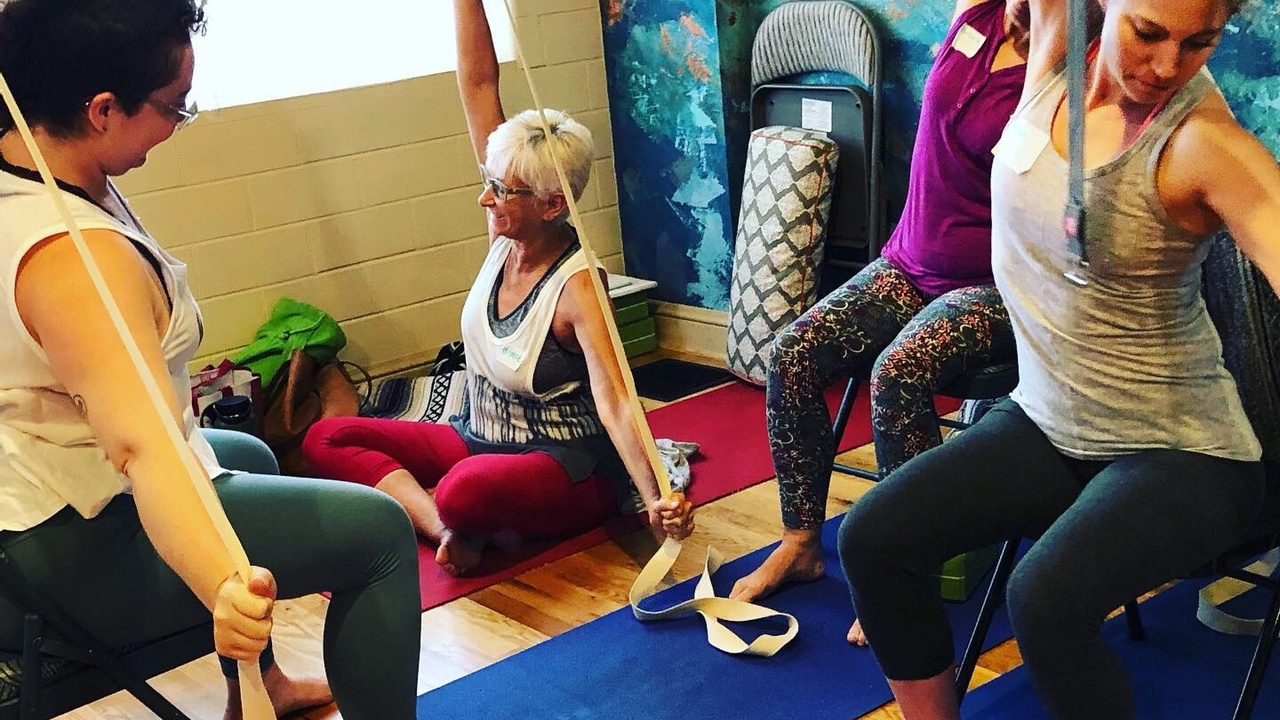https://www.accessibleyogaschool.com/blog/tips-for-accessibility
6 Tips for Yoga Teachers Moving Towards Accessibility

By Jivana Heyman
I’ve had so many people tell me, “I’m not flexible enough to do yoga.” Of course, flexibility doesn’t really have anything to do with yoga! So hearing this over and over can be incredibly frustrating. Honestly, it hurts my heart to think of all the people who avoid yoga, or worse, have negative experiences in yoga, because they think it’s about being flexible, strong, and agile.
If only they could see that yoga is about coming home to yourself, and that yoga is a practice for everyone.
I wonder how we got to this point? I guess it’s a combination of factors; a competitive industry with lots of money at stake, a colonizer mindset always looking to brand something, and our generally competitive nature. In many ways, the universal spiritual teachings of yoga are at odds with capitalism. So we’ve had to distort yoga to fit into our cultural norms.
The truth of yoga often isn’t shared or taught because it’s about giving people agency over their body and over their lives. It’s about empowering people to be truly independent. And that kind of independence may not be good for business.
Yoga teachers have an essential role in changing this dynamic. Here are 6 tips for yoga teachers moving toward greater accessibility in our yoga classes.
1. Focus on Universal Teachings
Before focusing on adapting practices, I ask teachers to start by instructing students in what yoga really is - an inward journey. The first step is to let go of the external orientation of performing poses in order to look a certain way. Rather, begin to explore interoception and the way the mind works. Consider the relationship between the mind and the breath, and the way the mind responds to movement, challenge, and relaxation. Spend time studying yoga scriptures to get a feel for what the ancient teachings hold as the purpose and goal of the practice.
2. Keep Students Safe
Teaching needs to begin with keeping students safe and empowering them to explore their own limits and potential. Alignment is not a prescribed thing but a way of moving safely. This means understanding common contraindications (such as spinal flexion with osteoporosis), and not judging one form as better or more advanced than another. Yoga is about self-awareness not gymnastics. As Matthew Sanford says, it’s about working from the inside out. Focus on finding the energetic alignment, or the subtle experience.
3. Adapt Practices
There are many helpful techniques to make asana accessible, which is a big part of what we explore in the Accessible Yoga Training. These techniques include using props to support the body, changing the orientation of poses, dissecting poses into parts, etc. Teachers can also personally benefit from having experience with adapting poses - since we’re all getting older, and most of us will get injured or sick along the way!
(For more on how to adapt popular yoga poses, join Jivana's free webinar today! Learn more here and register for a replay.)
4. Use Invitational Language
Consider the tone of your instructions. Are you commanding students to move their bodies in particular ways? Or, are you inviting them on an inner exploration? One way to invite students on a journey is to offer many variations of a practice and help them find the level that is best for them. We need to go of the idea that more is better, or that physically advanced asana equals advanced yoga, and we have to be skilled at seeing the practice as a spectrum of possibilities rather than a finite thing.
5. Teach Truly Mixed-Level Classes
By offering multiple levels of the same practice we can integrate people of different abilities into the same class rather than constantly segregating people by ability. This is an essential step toward true inclusion of people with disabilities.
Teachers need to find a way to teach practices in an integrated manner - that means teaching to all their students at the same time, rather than teaching one level of the practice to one group of students and then another (usually more gentle) version to another group of students. We can create a unified experience in the class even though from the outside it may look like the students are all doing different things. This integrated experience creates a powerful feeling of equality and cohesion in the group, rather than a hierarchy of "advanced" or "beginner" students.

6. Destigmatize Chair Yoga
I'm a big proponent of chair yoga, and I spend a lot of my time trying to show students how you can get much of the benefit of yoga from chair practice. Chair can also be combined with standing/wall work, or bed yoga. The chair is a prop that can add a wide range of participation, and can provide an empowering and positive experience for people who think that yoga is not for them.
With some effort, yoga teachers can transform the way that yoga is taught and practiced to be more inclusive and accessible. We have the power in our hands to open yoga to so many people who may be afraid to practice, or who have been injured or discouraged in the past. In doing so, we are embodying the key teaching of yoga – that we are all connected in spirit.
Again a fabulous resource generously shared. Thank you Deva Hardeep.
